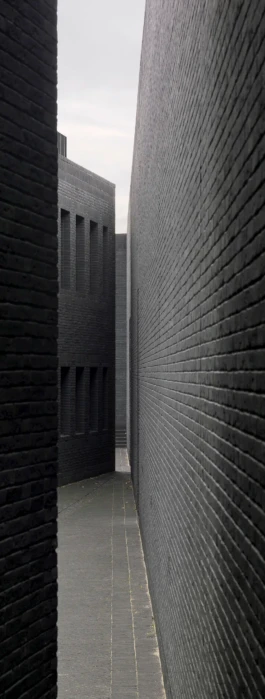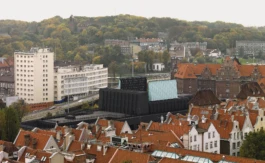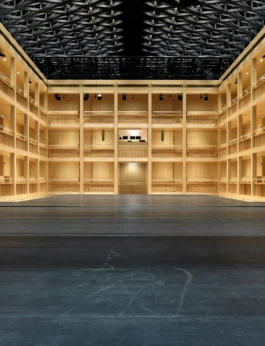Dear Renato,

The
Challenger
Flat Out asked me to write to a contemporary architect about a recently completed building. It was not difficult to choose. The Shakespeare Theatre in Gdańsk, Poland, that you recently completed (which, as you remember, was built from 2008 to 2014 after a competition you won in 2005) is probably the best building by an Italian architect since Giorgio Grassi’s restoration of the Roman theater in Sagunto (1985–93). My congratulations.
Not only does the building perfectly fit into the city, but—not content with just its amazing morphology and supreme typological precision—it is also surprisingly generous and spectacular inside. The generosity of the interior space (something that was always missing in buildings by architects of the Tendenza, for instance, who focused on typological correctness without any interest in space) adds a new dimension to what would otherwise be just another complacent and ostentatious exercise in erudition. The Shakespeare Theatre demonstrates an explicit pleasure in spatial articulation and also an unpredictable passion for technical exploit. The wooden hall of the theater opens to the sky by lifting its metal ceiling. The two halves of the ceiling rotate and open like iron wings that emerge in the city landscape. All of this adds an unexpected dimension to an otherwise perfectly “correct” project: the building resonates with a larger set of images, and somehow exposes an entire possible world of associations. Again: the building is amazing. And yet, there would not be much scope in this letter if I simply flattered you with compliments. The theater in Gdańsk is something worth being discussed. And my questions will be kind of flat out.
At this point I cannot ignore any longer a certain tone the building has for which I cannot feel much sympathy. Indeed, why all this darkness? Why this Götterdämmerung-like atmosphere? Is it really necessary? Are you really sure that typological precision and morphological inventions require this death-metal atmosphere? Is this tone not somehow suggesting arcane secrets and setting the stage for a kind of Illuminati pseudoscience? Is this really a good idea for architecture?
Hans Poelzig was not so severe. Albi Cathedral was less grim. Even George Dance’s Newgate Prison looks kind of serene compared to the Shakespeare Theatre. This tone suggests that the building is part of a conflict, as if the theater would somehow protest, oppose, and fight against the city where it belongs. But why protest? Why oppose? Is this something that architecture can really do? And even if it could—which I sincerely doubt—why do this? Why is all the indisputable artistic talent and architectural knowledge embedded in the design of the theater not being put to the service of the contemporary city?

Renato Rizzi, The Shakespeare Theatre, Gdansk, Poland, 2014. View of interstitial spaces.

Renato Rizzi, The Shakespeare Theatre, Gdansk, Poland, 2014. Aerial view of the theater with the roof wings open.
Is the darkness of the building a “message”? And if so, a message of what? Or is it just a by-product of an excess of self-destructive earnestness? In case it is a message, I fear what this message might be. If there was no intention to broadcast terror, then I wonder why you did not take into consideration this risk. Aren’t my cheap pop references obvious? How could you not think that teenagers would start calling the theater “the dark fortress” or “the Darth Vader spaceship”? Seriously, didn’t you ever think of that? And—in case you did not want to design that—wasn’t this misunderstanding worth taking care to avoid?
And, most importantly, if we understand architecture as protest, then we understand it as “message” and “communication” and we end up losing the specific relation of architecture to time, its peculiar indifference, and its opaque generosity. Shouldn’t we first of all make clear that architecture is not a medium? Because if architecture is a medium, then what would be the difference? You make buildings that say “you should be mourning,” while Bjarke Ingels makes buildings that say “you should be partying.” Is there any difference? Aren’t both approaches contrary to the specific incapacity of architecture to communicate? Again, if architecture accepts the ability to speak, isn’t it already lost? Why not be a bit more complacent—and at the same time a bit more elusive?

Renato Rizzi, The Shakespeare Theatre, Gdansk, Poland, 2014. Interior view of Elizabethan stage.
I write this because I think that my office produces—to a certain extent—similar projects. We both refer to buildings of the past and I suspect we both like bulky, fattish, windowless, and highly useless buildings. We both try to build something realistic and efficient starting from this counterintuitive starting point. I believe you do an excellent job in this. The Shakespeare Theatre looks impeccable not just in formal terms but also from a functional point of view.
The difference I see is that my office explicitly fears that our passion for sturdy buildings from the past could be misunderstood as some sort of reactionary ideology. So in the end our buildings always include some idiotic, unexpected elements, something that somehow does not entirely belong there. Most importantly, we are always careful not to communicate anything and keep our buildings as silent (or even better—dumb) as possible.
It seems like you do not care about this. You do not mind running the risk of being mistaken for some reactionary fanatic and I suspect this will reduce your opportunities to make more buildings, which would be sad, given how good they are.
All the best, and good luck for your next works.
Yours sincerely,
The Challenger
The Challenger was played by Pier Paolo Tamburelli in Flat Out 1 (Fall 2016).
Flat
Out
Benefactors
Graham Foundation for Advanced Studies in the Fine Arts
UIC Office of the Vice
Chancellor for Research
UIC College of Architecture, Design, and the Arts
Flat Out
Flat Out Inc. is a 501 (c) 3 tax-exempt not-for-profit organization registered in the state of Illinois.
Email editor@flatoutmag.org
This website is supported in part by the National Endowment of the Arts
Flat
Out
Benefactors
Graham Foundation for Advanced Studies in the Fine Arts
UIC Office of the Vice
Chancellor for Research
UIC College of Architecture, Design, and the Arts
Flat Out
Flat Out Inc. is a 501 (c) 3 tax-exempt not-for-profit organization registered in the state of Illinois.
Email editor@flatoutmag.org
This website is supported in part by the National Endowment of the Arts